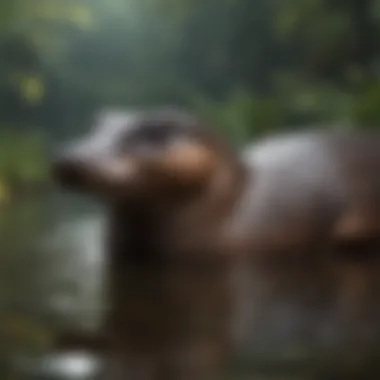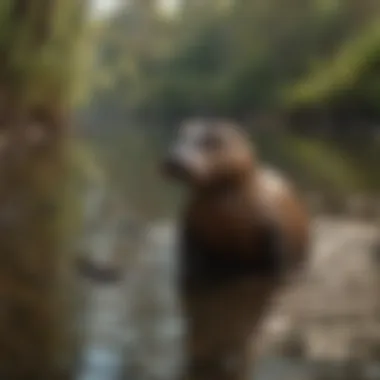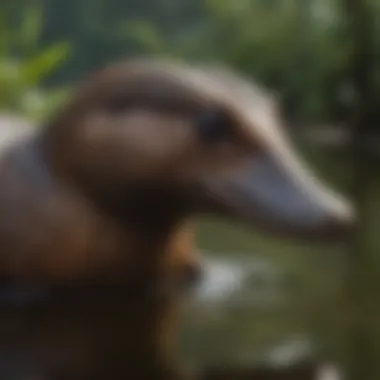Understanding the Endangerment of the Platypus


Intro
The platypus, a unique mammal native to Australia, presents an intriguing case in the discourse on wildlife endangerment. Its distinct blend of traits—such as a duck-bill, webbed feet, and the ability to lay eggs—has fascinated both scientists and the public alike. However, this remarkable creature faces a plethora of threats that jeopardize its very existence. To understand the endangerment of the platypus, one must first dive into its species profile, exploring the fundamental aspects of its life, habitat, and behavior.
Animal Species Profile
Prelims to the animal species
The platypus (Ornithorhynchus anatinus) is an egg-laying mammal belonging to a group known as monotremes. It is one of five extant species in this category, characterized by their reproductive method that is distinct from typical mammals.
Physical characteristics and appearance
Platypuses are easily recognizable due to their flat, duck-like bill and broad, paddle-shaped tail. Adult platypuses usually measure between 30 to 60 cm long. Their bodies are covered with dense fur that is water-resistant, aiding in insulation and buoyancy during foraging. The male platypus also possesses venomous spurs on its hind legs, a rarity among mammals.
Natural habitat and distribution
Found exclusively in eastern Australia, including Tasmania, platypuses inhabit freshwater rivers, lakes, and streams. They prefer areas with abundant vegetation and clean waters, which provide essential food sources and shelter.
Behavior and social interactions
Platypuses are primarily solitary animals, though they may come together during mating seasons. They are nocturnal foragers, feeding mostly on insects, worms, and crustaceans. Their behavior showcases unique adaptability, especially in their hunting techniques, which include using electroreception to detect prey underwater.
Conservation & Wildlife Efforts
Overview of conservation status
The platypus is currently classified as "near threatened" by the International Union for Conservation of Nature (IUCN). The population is declining due to various human-induced factors, which calls for immediate attention and action.
Threats to the species
Key threats to the platypus include:
- Habitat destruction due to urban development and agriculture
- Climate change impacting water levels and temperature
- Pollution from industrial runoff and plastics
- Invasive species that disrupt the food chain
Conservation initiatives and organizations
Numerous organizations, such as the Australian Conservation Foundation and the World Wildlife Fund, are actively working on projects aimed at conserving platypus populations. Their efforts include habitat restoration, awareness campaigns, and research programs focusing on how to mitigate the impacts of climate change.
Success stories and impact
Some areas have reported a rebound in local platypus numbers due to successful conservation efforts. Specific regions have implemented stricter pollution controls and habitat protections. These initiatives serve as examples of how targeted actions can yield positive results regarding platypus and ecosystem health.
Closure
Understanding and protecting the platypus is essential, as it plays a crucial role in its ecosystem. The plights of this species are a reminder of how interconnected we are with wildlife and the environment. Immediate action and continuous support for conservation efforts are vital to ensure the survival of this extraordinary animal.
Foreword to the Platypus
The platypus, a unique semi-aquatic mammal, holds a significant place in the ecosystem and within our collective understanding of wildlife. Known for its distinct characteristics, this creature serves as an indicator of environmental health. Examining the platypus is essential not only for its biological uniqueness but also for its role in its habitat. Recognizing its importance can lead to a deeper appreciation for conservation efforts surrounding this species. Understanding the platypus forms the foundation for the subsequent discussion on its endangerment. It opens up various avenues for conversation about environmental responsibility and the measures we can take to safeguard biodiversity.
Physical Characteristics
The platypus is an extraordinary animal. It is easily identifiable by its duck-bill, webbed feet, and flat tail. Adult platypuses typically measure about 50 to 60 centimeters in length and weigh between 1.5 to 2.5 kilograms. Their fur is dense and waterproof, which helps them to thrive in aquatic environments.
This unique morphology is not just for show; it allows the platypus to hunt efficiently. The bill is embedded with electroreceptors, which help them locate prey underwater. The webbed feet aid in swimming, while the claws enable them to dig burrows on land. These adaptations illustrate how well-suited the platypus is to its environment.
Habitat and Distribution
Platypuses are endemic to eastern Australia, including Tasmania. They thrive in freshwater bodies, such as rivers, streams, and lakes. Their habitats are typically characterized by a mix of aquatic vegetation and stable banks, which are essential for their nesting.
The distribution of the platypus coincides with healthy freshwater ecosystems. They require clean water for feeding and breeding. However, habitat degradation and pollution threaten their homes, highlighting the urgent need for conservation measures. Protecting the natural habitats of the platypus is crucial for their survival as well as for maintaining the ecological balance.


"The health of the platypus is a reflection of the health of our waterways. Protecting them protects our environment."
This holistic understanding of the platypus, encompassing its physical traits and current habitats, establishes the groundwork needed to explore the challenges it faces today. Without this fundamental knowledge, the conversation about their endangerment remains incomplete.
Current Status of the Platypus
The platypus is a unique creature, but its current status is concerning. Understanding this status gives insight into the challenges that the species faces. It allows us to grasp the extent of population decline and the implications of being classified under various conservation statuses. Both elements are interconnected and critical for wildlife management and conservation efforts. Without being informed about the current status, it is difficult to comprehend what can be done to protect this extraordinary mammal.
Population Decline
The population of the platypus has seen a significant decrease over the last few decades. Various factors contribute to this decline, including habitat loss and environmental changes. According to various studies, it is estimated that populations have dropped by nearly 30% in certain regions. This decline is alarming as it affects genetic diversity and the overall resilience of the species.
A few reasons for the decline include:
- Habitat destruction: Urbanization and agricultural practices have led to the fragmentation of their natural environments.
- Water pollution: Contamination of waterways disrupts not only the platypus but also their food sources.
- Drought conditions: Extended periods of low water levels impact nesting sites and foraging areas.
"Every decline in population not only represents fewer animals but also a step closer to extinction for the species."
Conservation Status
The conservation status of the platypus is assessed by various organizations, including the International Union for Conservation of Nature (IUCN). Currently, it is classified as Near Threatened. This classification indicates that while the species is not critically endangered, it is facing serious threats that could lead to a risk of extinction if conditions do not improve.
The different factors influencing their conservation status include:
- Legal protections: In Australia, laws exist to protect the platypus, but enforcement can vary greatly based on location.
- Ongoing research: Studies are crucial for monitoring platypus populations and understanding the ecological impacts affecting them.
Overall, the conservation status of the platypus highlights the urgent need for strategies that can reverse the decline in numbers. Collaboration among scientists, governments, and local communities is essential in developing effective conservation initiatives.
Primary Threats to the Platypus
The endangerment of the platypus is largely due to a variety of threats that stem from both natural and human-induced factors. Understanding these threats is crucial for formulating effective conservation strategies. Each threat contributes in its own unique way to the decline of platypus populations. Addressing these threats requires a comprehensive understanding of how they interact and exacerbate each other. This section delves into the specific threats faced by the platypus, focusing on habitat loss, climate change, pollution, invasive species, and human activities.
Habitat Loss
Habitat loss is one of the most pressing issues concerning the platypus. As human populations expand, natural areas diminish. The primary causes of habitat loss include land development, agricultural expansion, and urbanization.
Land Development
Land development is a prominent factor threatening the platypus. As regions transform for housing and commercial use, areas crucial for platypus survival are compromised. This type of development often results in the destruction of waterways and wetlands. The striking characteristic of land development is its immediacy, making it a highly visible threat. Environmental regulations can sometimes mitigate this, but they are often minimal or poorly enforced. The unique feature of this threat lies in its permanence; once land is developed, it rarely returns to its natural state, creating long-term consequences for wildlife.
Agricultural Expansion
Agricultural expansion poses significant challenges to the platypus's habitat. As farmers convert natural landscapes into farmland, vital areas for food and breeding are lost. This kind of expansion often leads to increased water use and pollution. A key characteristic of agricultural land is its alteration of local ecosystems, which can disrupt the delicate balance necessary for the platypus's survival. Additionally, agricultural practices can introduce pesticides and fertilizers that further degrade the environment. The unique challenge posed by this expansion is the often covert and gradual nature of the damage it inflicts, making it less visible to the casual observer yet profoundly impactful.
Urbanization
Urbanization greatly impacts the platypus by altering the waterways they inhabit. As cities grow, cement and concrete replace natural landscapes. A primary characteristic of urban areas is resource consumption, leading to increased runoff and disrupted water flow. This contributes to the loss of suitable habitats for platypus. The unique aspect of urbanization lies in how it reshapes the natural landscape, often leaving a fragmented environment. This fragmentation can isolate populations, making it difficult for them to find mates or adequate resources.
Climate Change
Climate change is increasingly recognized as a significant threat to the platypus. Its impact is seen through various mechanisms, including changes in water availability, temperature variability, and extreme weather events.
Changes in Water Availability
Changes in water availability directly affect the platypus, which relies heavily on stable water sources. Droughts and shifting rainfall patterns can drastically reduce river flows and wetland areas. A major characteristic of this change is its unpredictability, making it difficult for the platypus to adapt. The unique feature of changing water availability is the potential for entire ecosystems to collapse if water sources dry up, affecting all species dependent on these habitats.
Temperature Variability
Temperature variability influences the platypus, particularly regarding breeding and food availability. Extreme temperature fluctuations can stress populations, impacting their reproductive success. A defining characteristic of temperature variability is its direct influence on the species’ physiological health. The unique aspect here is the potential for heatwaves and cold snaps to change local ecosystems, leading to declines in food sources vital for the platypus’s survival.
Extreme Weather Events
Extreme weather events are becoming more frequent due to climate change. Floods and storms can destroy habitats and displace platypuses. A critical characteristic of these events is their capacity for immediate and widespread destruction. Their unique feature lies in their unpredictability—communities may not be prepared for such occurrences, resulting in loss that may take years to recover from.


Pollution
Pollution represents a multifaceted threat to the platypus, with various forms affecting their habitats and health. Major forms include chemical contaminants, plastic waste, and overall water quality degradation.
Chemical Contaminants
Chemical contaminants from agricultural and industrial sources can enter waterways, posing serious risks to the platypus. A key characteristic of these contaminants is their toxicity, which can accumulate in the food chain. The unique aspect of chemical pollution is its often invisible nature, making it difficult to detect until significant damage is done to ecosystems and species.
Plastic Waste
Plastic waste found in rivers and streams presents a significant hazard. Not only does it pollute habitats, but it also poses ingestion threats to wildlife. The important characteristic of plastics is their persistence in the environment. The unique feature here is the potential for microplastics to enter the food chain, impacting not just the platypus but countless other species.
Water Quality Degradation
The degradation of water quality affects the entire ecosystem. Poor water quality can lead to decreased food sources and increased illness in wildlife. A defining characteristic of degraded water quality is its gradual nature, making it often overlooked until it reaches critical levels. The unique challenge of water quality degradation is the cumulative effect it has on entire habitats, altering the availability of resources necessary for survival.
Invasive Species
Invasive species can threaten native wildlife, including the platypus. They compete for resources and can become predators.
Competition for Resources
Invasive species often compete with the platypus for food and habitat. This competition can greatly reduce the available resources for the platypus. A primary characteristic of such competition is its intensity; invasive species can outcompete native wildlife rapidly. The unique aspect of this threat is how it can lead to a decline in birth rates and overall population, making recovery efforts more challenging.
Predation
Predation by invasive species poses a severe risk to the platypus. These foreign species can directly hunt or prey on baby platypuses, leading to increased mortality rates. An important characteristic of predation is its direct impact on population numbers. The unique feature here is how predation can shift ecological balances, leading to further declines in native species.
Human Activities
Human activities also significantly endanger the platypus. Recreational impact, fishing practices, and water management play crucial roles in the deterioration of their environments.
Recreational Impact
Recreational activities can disturb platypus habitats, leading to stress on these sensitive creatures. A defining characteristic is the frequency and type of activities that occur. The unique challenge here is balancing human enjoyment and environmental preservation.
Fishing Practices
Fishing practices can harm platypus populations, especially through bycatch or habitat disruption. An important aspect is the technique used, as some methods are more destructive than others. The unique feature of this threat is the unintended consequences it may have on platypus food sources, leading to further population pressures.
Water Management
Water management policies can have mixed effects on platypus habitats. While they aim to provide adequate water supplies, they can also alter natural flow patterns. A key characteristic of water management is its strategic nature, impacting entire ecosystems. The unique aspect of this management is how mismanagement can lead to droughts or floods, further threatening the survival of the platypus.
Understanding these threats is essential for developing mitigative actions. Awareness and education can drive the necessary changes to address these challenges effectively.
The Role of Conservation Efforts
Conservation efforts play a crucial role in preserving the platypus. Given its unique biological and ecological characteristics, protecting this species requires tailored strategies. Focusing on specific actions not only helps to mitigate the threats faced by the platypus but also enhances biodiversity in its environment. As habitat loss and climate change continue, effective conservation becomes even more pressing. The commitment from various sectors, including governments and local communities, is essential to ensure sustainable solutions are implemented.
Current Conservation Strategies
Protected Areas
Protected areas are designated regions that offer a safe haven for wildlife, including the platypus. These spaces are aimed to preserve critical habitats and maintain ecological balance. One key characteristic of protected areas is their legal status, which often restricts harmful activities such as urban development and intensive agriculture. This makes them a popular choice in conservation efforts.
The unique feature of protected areas is their ability to provide a controlled environment where nature can regenerate. They limit human interference that could disrupt delicate ecosystems. The advantages of these areas include the fostering of biodiversity and offering refuge for the platypus in times of environmental change. However, their disadvantage may include limited resources for management and enforcement which can vary significantly from one site to another. Some protected areas may not sufficiently cover all the necessary habitats of this species, leading to gaps in conservation efforts.
Species Recovery Programs
Species recovery programs target specific endangered animals, offering them protection and promoting their populations. The key characteristic of these programs is their focus on rehabilitation and reintroduction strategies. These are crucial for restoring the platypus population, which has seen dramatic declines. Such programs are beneficial as they tailor activities to the needs of the platypus, significantly increasing the species’ survival chances.


A unique feature of species recovery programs is their collaborative nature. These initiatives often involve the cooperation of researchers, local communities, and government bodies, creating a network of support for the species. The advantage of this approach is it leverages diverse expertise and resources, enhancing the chance of success. However, challenges remain, such as funding security and long-term commitment from involved parties, which can hinder progress.
Importance of Habitat Restoration
Habitat restoration is essential for the survival of the platypus. As human activities lead to significant alterations in natural landscapes, restoring these environments can help to revive populations. This process involves re-establishing native flora and fauna, improving water quality, and enhancing the overall ecosystem. Key benefits include increased biodiversity and a healthier environment, making it conducive for the platypus to thrive.
Community Involvement
Community involvement is a pivotal element in conservation strategies. Engaging local populations can foster a sense of ownership over natural resources and create advocates for the platypus. Educational programs enhance understanding and appreciation for this unique species. When communities actively participate in conservation efforts, the outcomes tend to be more sustainable. Grassroots movements may address local concerns and tailor solutions to meet specific needs, strengthening the overall conservation framework.
Public Awareness and Education
Awareness and education are essential in addressing the endangerment of the platypus. Heightened public consciousness facilitates understanding of the threats faced by this unique species. When people are informed about the factors contributing to the decline, they become motivated to participate in conservation efforts. Education encourages the general public to take responsibility for protecting wildlife and their habitats.
Raising Awareness
Educational Programs
Educational programs play a crucial role in promoting awareness about the platypus and the challenges it encounters. These programs often engage various age groups, from school children to adults, through workshops, lectures, and hands-on activities. The key characteristic of educational programs is their ability to foster a deep emotional connection to wildlife. They allow participants to understand how their actions can impact ecosystems.
One significant aspect of these programs is the incorporation of field trips to natural habitats where platypuses reside. Participants can witness the animal in its environment, enhancing their appreciation for this unique creature. However, one disadvantage can be the limited reach of these programs, often dependent on local resources. This limitation can prevent wider distribution of knowledge about the platypus.
Media Campaigns
Media campaigns serve as a powerful tool for spreading information on the importance of protecting the platypus. These campaigns utilize various platforms, including social media, television, and print, to convey urgent messages about the species' endangered status. A key characteristic of media campaigns is their broad reach, allowing for information dissemination to large audiences in a short time.
One unique feature of media campaigns is their capacity to leverage visual storytelling. Engaging imagery and videos can evoke emotions and prompt action. Though effective, media campaigns face the challenge of fleeting public attention, as messages often get lost in the noise. Nonetheless, a successful campaign can spark significant public interest and lead to tangible conservation results.
The Role of Advocacy Groups
Advocacy groups play a vital part in enhancing public awareness and driving conservation efforts. These organizations often focus on raising the profile of endangered species like the platypus. By engaging with the public and communities, they push for larger systemic changes that support wildlife protection. Their efforts include lobbying for protective legislation and organizing community events.
Advocacy groups also aid in spreading educational materials, increasing community participation in conservation activities. This grassroots approach is fundamental as it empowers individuals to contribute positively toward the future of the platypus.
"Public awareness is foundational for conservation. Without knowledge, there can be no progress."
Future Outlook for the Platypus
The future of the platypus is contingent on various environmental and human factors. Understanding these factors is essential for creating effective conservation strategies. The platypus, with its unique characteristics, faces numerous threats that endanger its survival. Therefore, continuous assessment of the situation is crucial.
Predicted Trends
Research indicates that the population of the platypus is likely to decline further if current trends continue. Here are key predictions for the species:
- Habitat Degradation: Development and urban expansion will continue to erode natural habitats, leading to increased fragmentation of the ecosystems.
- Climate Change: Unpredictable weather patterns may exacerbate the already strained water resources crucial for the platypus's survival. Changes in rainfall patterns could impact breeding and food availability.
- Water Quality: Persistent pollution will likely decrease the quality of water bodies. This would not only affect food availability but also increase the risk of diseases and health problems in platypus populations.
- Invasive Species: The establishment of non-native species is set to intensify competition for resources. This competition can hinder the growth of the platypus population.
Understanding these trends helps in identifying potential areas of intervention.
Steps Towards Recovery
Recovery efforts must be multifaceted and strategic. Here are essential steps that can assist in revitalizing platypus populations:
- Habitat Restoration: Restoring damaged ecosystems is a primary focus. This includes reforestation and the rehabilitation of riverbanks to support wildlife.
- Legal Protection: Enforcing stricter regulations against habitat destruction and resource exploitation can give the platypus a fighting chance.
- Research and Monitoring: Ongoing research into platypus populations and their environments will provide data necessary for informed decision-making. Regular monitoring can help adapt strategies as needs change.
- Community Engagement: Inviting locals to participate in conservation efforts can foster a deeper connection with the platypus and its habitat. Nonprofit organizations often provide resources for this.
Finale
The issue of platypus endangerment is urgent and multifaceted. Recognizing the complexities of their plight is essential for developing effective conservation strategies. This section synthesizes the key points discussed previously and emphasizes the critical need for immediate action to address the ongoing threats.
The Importance of Immediate Action
The survival of the platypus depends largely on timely intervention. Numerous factors contribute to their decline, such as habitat destruction, climate change, and pollution. Thus, immediate action is not just beneficial but necessary. By acting swiftly, we can mitigate these threats and protect their natural habitat. Some potential actions include:
- Legal Protections: Enacting stronger laws can safeguard habitats from developments that threaten wildlife.
- Restoration Projects: Engaging in habitat restoration can help revive ecosystems that are crucial for the platypus’ survival.
- Community Initiatives: Involving local communities in conservation efforts fosters a sense of responsibility towards the environment.
"To ignore the danger facing the platypus is to disregard the intricate balance of our ecosystems."
Furthermore, public awareness campaigns can catalyze collective action. Educating individuals about the importance of the platypus not only inspires action but also encourages a culture of conservation.
Ultimately, the urgency of the platypus’ situation demands a comprehensive and immediate response. The wealth of biodiversity it represents is invaluable. Prolonging inaction only exacerbates the risks they face, and jeopardizing one species can disrupt entire ecosystems.







